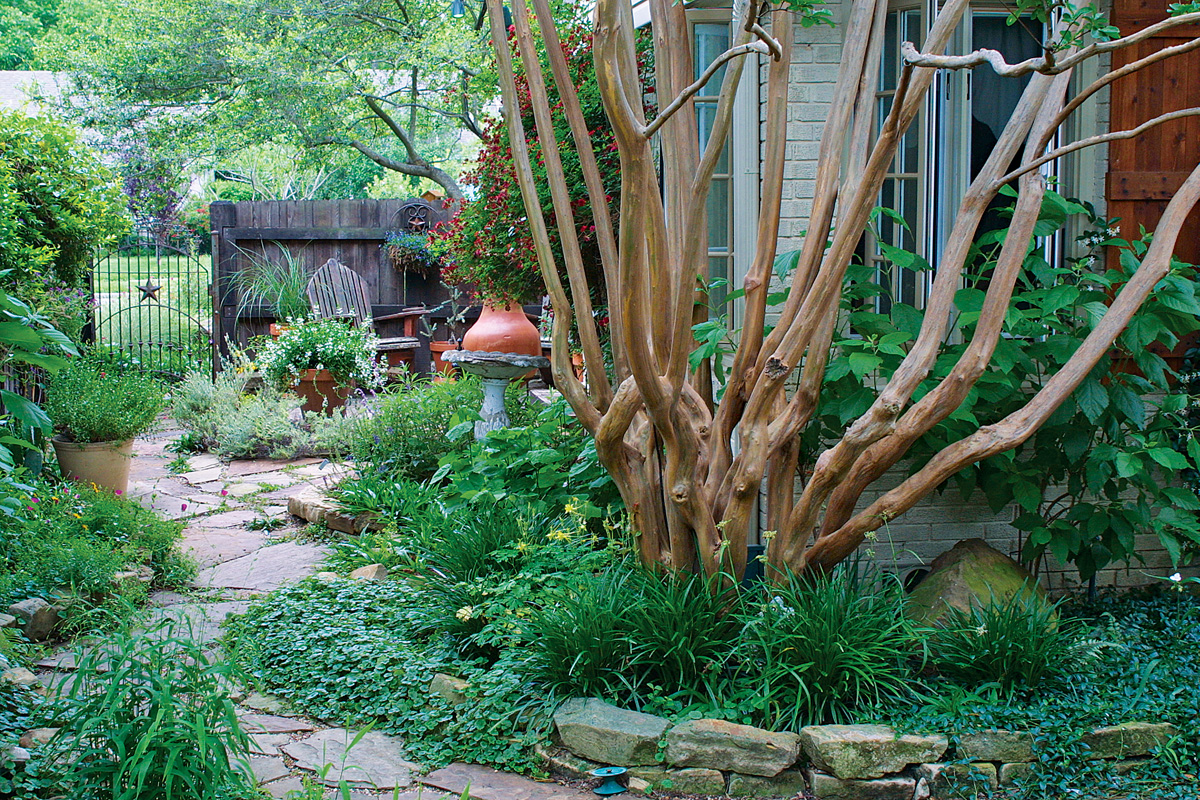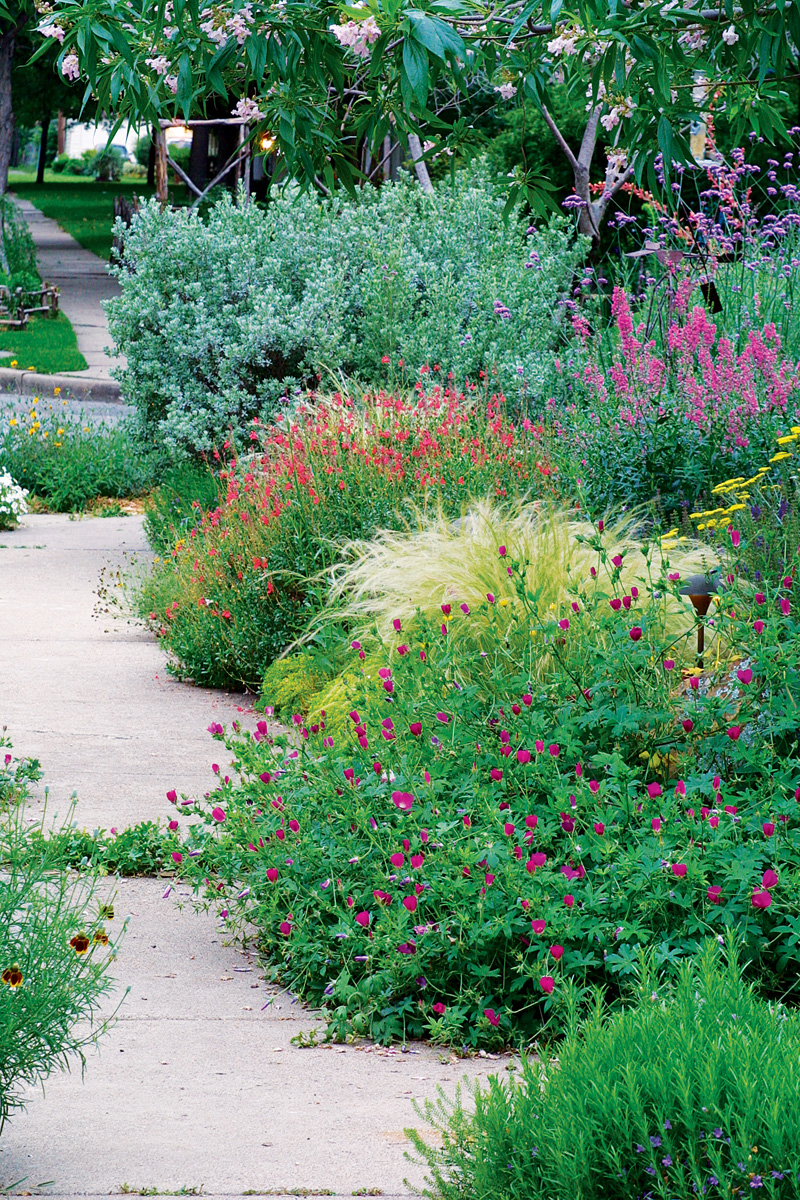Planning a Garden: Right Plants, Right Places
Taking the first rule of gardening to heart, you can create a beautiful, low-maintenance landscape

Our house rests in the middle of a Texas Hill Country landscape. We have always loved the look and feel of this environment, and we knew that when we bought a house that we would surround it with a setting that matched our dreams. But rather than sitting on a sprawling ranch on the plains, our house rests on a small urban lot.
Learn more about planting in the Southern Plains region
When we moved to our property 20 years ago, all we had was a flat green lawn and some evergreen shrubs surrounding the house. Since then, by learning to appreciate and cooperate with our ecosystem, we have established a low-maintenance garden that looks like it belongs exactly where it is. We’ve done this by carefully selecting plants that have a high probability of thriving in our garden with minimal involvement from us. We then placed those plants in spots where they would be most likely to succeed and that would take advantage of their natural form and texture. While our garden is pure Texas, the methods we have employed can be used anywhere by anyone who desires a natural, low-maintenance garden.
Think about what you want from a plant
Combine what you want with what the plant needs. The right place for a plant can depend on how you use an area. The fragrant jasmine makes this porch off the bedroom particularly enjoyable.

We carefully research our options before we choose a plant for our garden. This ensures that our selections harmonize with the natural surroundings and will thrive on minimal upkeep. Knowing that we want these qualities helps us focus our choices and keeps us from even thinking about plants that just wouldn’t contribute to the garden we want.
Our first considerations when selecting a plant are its requirements and tolerance for moisture, wind, soil, climate, and exposure. We have come to rely on native plants because they can handle the hot Texas sun and high humidity while still putting on a fabulous display of color throughout the year.
We next focus on the area to be planted. If we follow what the landscape tells us, we discover that the garden is waiting to be revealed. The landscape determines what plants look best, grow best, or grow at all. In one area at the front of our yard, for example, the ground slopes down toward the street. The spot gets full sun, and the soil is well drained but low in fertility. These conditions tell us that plants such as blackfoot daisy (Melampodium leucanthum, USDA Hardiness Zones 7–11) and four-nerve daisy (Hymenoxys scaposa, Zones 4–9)—neither of which likes wet feet—will thrive in this spot.

We also choose plants to match the Texas Hill Country look we want. We planted the open areas of the yard with ‘609’ buffalo grass (Buchloe dactyloides ‘609’, Zones 3–11) to create a sense of the prairie, with the grass whipping and waving in the breeze. It flows into the rest of the landscape, making the edges look soft and natural. Buffalo grass also has the low-maintenance and drought-tolerant characteristics of our other plants.
By choosing only those plants that can handle our conditions, we have avoided ones whose poor health makes them susceptible to pests and diseases as well as ones that take a great deal of effort to look good for a short period of time.
Let plants show you where to grow

To increase the natural look of our garden and to decrease the maintenance we do, we let our plants show us where they like to grow. We encourage self-sowing because it not only creates a more natural pattern to the garden but also teaches us what conditions a plant enjoys or tolerates. Zexmenia (Zexmenia hispida, Zones 8–10) is one of the most dependable flowers for long-lasting summer color, and its habit of reseeding lends a natural permanence to the garden. Mexican feather grass (Nasella tenuissima, Zones 7–11), tall verbena (Verbena bonariensis, Zones 7–11), and Dahlberg daisies (Thymophylla tenuiloba, annual) have seeded themselves in the natural decomposed granite pathway, making the entryway more inviting.
We also learn where to place our plants by observing where they grow in nature. You can’t get any better than what nature provides; you just need to open your eyes. We’ve found yellow columbine (Aquilegia chrysantha var. hinckleyana, Zones 3–9), northern sea oats (Chasmanthium latifolium, Zones 5–9), and spiderwort (Tradescantia × andersoniana, Zones 5–9) growing in the wild under a grand old tree. We’ve chosen to use these plants under yaupon holly (Ilex vomitoria, Zones 7–11) and crape myrtle (Lagerstroemia spp. and cvs., Zones 7–9) to create a colorful shade garden with a mix of native woodland plants.
Our plants reveal the different microclimates in our garden. We adjust our design if we notice that a plant reaches into or out of the sun, that something pouts in the heat, or that a plant rots due to poor drainage. As we become more familiar with these microclimates, we choose plants that are naturally suited to similar situations.
Our courtyard is one area with a distinct microclimate. It is protected from the north wind and maintains slightly higher temperatures throughout winter. We take advantage of this by using plants that need things a little warmer, like prickly pear cactus (Opuntia spp., Zone 11) and false aloe (Manfreda virginica, Zones 6–9).
In the front yard, desert willows (Chilopsis linearis, Zones 8–9) and catalpas (Catalpa bignonioides and cvs., Zones 5–9) create filtered shade. It provides relief from the hot Texas sun for the ‘May Night’ meadow sage (Salvia × sylvestris ‘May Night’, Zones 5–9). The willows and catalpas also provide a flowering canopy of color and nectar for wildlife.
Use a plant’s personality to your advantage

Plants have personalities, and we’ve learned to incorporate these into our design. By knowing a plant’s natural habit and tendencies, we can place it where those characteristics will have the best effect. We also avoid spending time and effort trying to make a plant into something it’s not.
The loose, sprawling habit of winecups (Callirhoe involucrata, Zones 4–9) lends itself to a natural-looking garden, and we let it spill into the entrance to our front path. We love ‘Heavy Metal’ switch grass (Panicum virgatum ‘Heavy Metal’, Zones 5–9) for its narrow, erect clumps; it’s particularly nice with other vertical plants like narrow-leaf gayfeather (Liatris mucronata, Zones 4–9) and tall verbena.

We also use the height and texture of red mountain sage (Salvia darcyi, Zones 8–10) to provide a transition between the prickly pear cactus and the structurally formed sotol (Dasylirion wheeleri, Zones 8–11). Besides blooming all summer and fall, red mountain sage provides nectar for butterflies, bees, and hummingbirds.
The result of our efforts is a relaxed, low-maintenance, natural garden that matches our house, our environment, and our dreams.
Design
Looking great doesn’t require a lot of effort

It’s possible to have a garden that is both beautiful and easy to maintain. Here are solutions to some time-consuming tasks.
Task: Watering
Solution: Use drought-tolerant plants, especially in areas far from a water source. Choices abound among plants that don’t need any more water than what nature provides.
Task: Mowing
Solution: Plant grass that does not need to be mowed. Our buffalo grass (photo, right) looks better tall, and we’ve limited the area we devote to it.
Task: Pruning
Solution: Allow trees and shrubs their natural habit. We want our plants to look how nature intended them to. Trying to make a sprawling shrub into a tight bush is a waste of time. Avoid this by choosing a plant with the right size and habit to begin with.
Task: Deadheading
Solution: Let plants self-sow. The only plants we cut back are ones that benefit from it. We let the others be. Anything that grows where we don’t want it gets pulled or potted up.
Task: Caring for sick plants
Solution: Move them. A plant that has consistent problems is probably in the wrong spot and should be replaced by a plant better suited to the conditions in that spot.
Fine Gardening Recommended Products

The Crevice Garden: How to make the perfect home for plants from rocky places
Fine Gardening receives a commission for items purchased through links on this site, including Amazon Associates and other affiliate advertising programs.

A.M. Leonard Deluxe Soil Knife & Leather Sheath Combo
Fine Gardening receives a commission for items purchased through links on this site, including Amazon Associates and other affiliate advertising programs.

Buffalo-Style Gardens: Create a Quirky, One-of-a-Kind Private Garden with Eye-Catching Designs
Fine Gardening receives a commission for items purchased through links on this site, including Amazon Associates and other affiliate advertising programs.






Comments
Log in or create an account to post a comment.
Sign up Log in